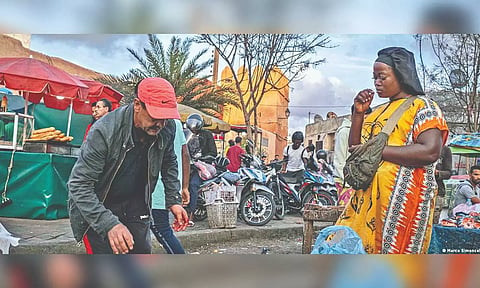

• MARCO SIMONCELLI
RABAT: From her apartment in Hay Charaf, a residential neighborhood in the northern suburbs of Marrakech in Morocco, Oumou Sall cares for her newborn baby. The 27-year-old Senegalese woman moved to Morocco in 2017 to complete her master’s degree in business management. She is now on maternity leave, but in a week’s time she will return to work in a call center — one among many in the city. Oumou’s story is similar to many other women from sub-Saharan Africa who are migrating to the North African country in increasing numbers. According to the last official figures released by the United Nations in 2020, 48.5% of Morocco’s regular migrant population are women.
Fitting in wasn’t difficult, she said: “I found other sub-Saharan [migrants] in the firm and relations with bosses were good.” Morocco’s changing job landscape means it is no longer just a stopover on the long migration route to Europe, but a possible destination for many women seeking higher-paying jobs to support themselves and their families.
Morocco’s call center industry has undergone a boom over the past 15 years, making it easier for many French-speaking migrants to find work. Oumou, who is originally from Dakar, said getting hired in call centers is simple enough even without a degree — a good knowledge of French is usually sufficient.
Her fixed pay is 2,500 dirhams ($340) a month, alongside various performance-based bonuses — enough to send remittances back to her family in Senegal. “We actually work for rewards,” Oumou explains. “So if we get them and get good results, then we can send money back to our families and save money.”
About 250 km south of Marrakech, in the Cite Essalam area of Agadir, Senegalese entrepreneur Khady Wade Balde elegantly welcomes her clients — mostly Moroccan women — in one of her beauty salons, “Khady Hair”. While watching over her team of about a dozen employees, she recounts her solo journey to Morocco in 2008. The then-23-year-old came with a plan to improve her hairdressing skills. She secured an apprenticeship under the guidance of a Moroccan mentor and, after years of work and personal sacrifice, she eventually opened her first salon.
“At the time, sub-Saharan African women were just taking babysitting (jobs),” she said. “There were no hairdressers like today. At first they thought I was a maid, but I wanted to be a hairdresser.” Today, Khady is a sought-after hairdresser in her area. She said she’s satisfied with what she’s achieved here as a migrant, but is aware of the enormous difficulties faced by other sub-Saharan women in Morocco.
“I don’t know (what goes on) in other people’s lives, but I know it is hard for some of them. It is not as easy for everyone as it was for me.” For every success story like Khady’s, there are many more women who are stuck in limbo. There are a reported 70,000 to 200,000 sub-Saharan migrants in Morocco — many of them undocumented. Women without documentation are particularly vulnerable to various forms of exploitation and marginalization, especially in the agricultural and domestic service sectors. Faced with growing numbers of migrants, Rabat has also been forced to review its integration policies. Two regularization campaigns in 2014 and 2017 enabled some 50,000 migrants — many from sub-Saharan Africa — to obtain residence permits. Aida Kheireddine, a Moroccan researcher and expert in gender and migration, says these campaigns were initially beneficial for the migrant community.